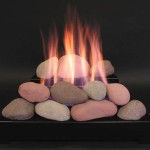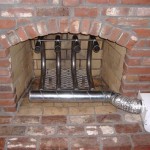Brass Fireplace Doors: Aesthetics, Functionality, and Maintenance
Brass fireplace doors represent a classic and enduring choice for homeowners seeking to enhance the aesthetic appeal and functionality of their fireplaces. These doors are not merely decorative elements; they serve several practical purposes, including improving energy efficiency, increasing safety, and reducing the amount of ash and debris entering the living space. The selection of brass fireplace doors involves considering various factors, such as design, construction materials, and maintenance requirements.
The allure of brass lies in its warm, golden hue and its ability to complement a wide range of interior design styles, from traditional to contemporary. Brass's inherent durability and resistance to corrosion make it a suitable material for fireplace accessories, ensuring that brass fireplace doors maintain their appearance and structural integrity over time. Understanding the types of brass available, the design considerations, and the proper cleaning and maintenance techniques are crucial for making an informed decision about purchasing and caring for brass fireplace doors.
Types of Brass and Construction Materials
The term "brass" encompasses a family of alloys primarily composed of copper and zinc. The proportions of these metals influence the brass's color, strength, and corrosion resistance. Several types of brass are commonly used in the manufacturing of fireplace doors, each possessing unique characteristics:
Yellow Brass (Cartridge Brass): This widely used brass alloy consists of approximately 70% copper and 30% zinc. It is known for its excellent ductility and malleability, making it suitable for forming intricate designs. Yellow brass exhibits a bright, golden color but is more susceptible to tarnishing than other brass alloys.
Red Brass (Gilding Metal): Containing a higher copper content (around 85-90%), red brass possesses a reddish-golden hue and superior corrosion resistance compared to yellow brass. It is frequently used in applications where exposure to moisture or harsh environments is a concern.
Naval Brass: This alloy incorporates a small percentage of tin (typically around 1%) in addition to copper and zinc. The addition of tin enhances naval brass's resistance to corrosion, particularly in saltwater environments. While not commonly used in standard fireplace doors, it might be considered for coastal properties where corrosion is a significant factor.
Brass-Plated Steel: To reduce the cost of manufacturing, some fireplace doors feature a steel frame and components coated with a thin layer of brass. These doors offer a similar aesthetic appearance to solid brass doors but are generally less expensive and less durable. The brass plating can wear off over time, exposing the underlying steel, which is susceptible to rust.
In addition to the brass components, fireplace doors incorporate other materials such as glass, steel, and cast iron. The glass panels are typically tempered to withstand the high temperatures generated by a fireplace. Steel frames provide structural support, while cast iron is sometimes used for decorative elements. The quality of these materials significantly impacts the overall performance and longevity of the fireplace doors.
Design Considerations for Brass Fireplace Doors
The design of brass fireplace doors plays a crucial role in enhancing the aesthetic appeal of a fireplace and complementing the overall decor of the room. Numerous design options are available, ranging from simple and understated to ornate and elaborate. Several factors influence the selection of an appropriate design:
Style: Fireplace doors are available in various styles, including traditional, contemporary, and rustic. Traditional designs often incorporate intricate scrollwork, floral motifs, and antique finishes. Contemporary designs emphasize clean lines, geometric shapes, and minimalist aesthetics. Rustic designs often feature distressed finishes, hammered textures, and elements that evoke a sense of natural materials.
Door Type: The type of door is another important consideration. Bi-fold doors consist of two panels that fold inward, providing a wide opening for tending to the fire. Single-panel doors swing open on hinges, offering a simpler and more streamlined appearance. Sliding doors move horizontally along a track, conserving space and providing easy access to the fireplace.
Glass Type: The glass panels in fireplace doors can be clear, tinted, or textured. Clear glass provides an unobstructed view of the fire, while tinted glass can reduce glare and filter the light. Textured glass adds visual interest and can obscure the view of the fire to varying degrees.
Finish: The finish of the brass components can significantly impact the overall appearance of the fireplace doors. Polished brass exhibits a bright, reflective shine, while antique brass features a darker, more subdued finish with a vintage aesthetic. Other finishes, such as brushed brass and satin brass, offer a more subtle and contemporary look.
Size and Fit: Fireplace doors must be properly sized to fit the fireplace opening. Accurate measurements are essential to ensure a secure and aesthetically pleasing fit. Overlapping doors provide a margin of error and are more forgiving of minor variations in the fireplace opening. Inset doors are designed to fit flush with the fireplace surround, creating a seamless and integrated look.
Cleaning and Maintenance of Brass Fireplace Doors
Proper cleaning and maintenance are essential for preserving the beauty and extending the lifespan of brass fireplace doors. Brass is susceptible to tarnishing, a chemical reaction between the metal and oxygen in the air. Regular cleaning can remove tarnish and prevent it from building up. Several methods can be used to clean brass, ranging from simple household solutions to specialized brass cleaners.
Mild Soap and Water: For lightly tarnished brass, a solution of mild soap and water can be effective. Gently wipe the brass surfaces with a soft cloth dampened with the soapy water, then rinse with clean water and dry thoroughly. Avoid using abrasive cleaners or scrub brushes, as they can scratch the brass finish.
Brass-Specific Cleaners: Numerous brass-specific cleaners are available commercially. These cleaners typically contain mild abrasives and chemicals that dissolve tarnish. Follow the manufacturer's instructions carefully when using these products. Apply the cleaner to a soft cloth and rub gently on the brass surfaces, then rinse with clean water and dry thoroughly.
Homemade Cleaning Solutions: Several homemade cleaning solutions can be used to remove tarnish from brass. A paste made from lemon juice and baking soda can be effective for removing stubborn tarnish. Apply the paste to the brass surfaces, let it sit for a few minutes, then scrub gently with a soft cloth and rinse with clean water and dry thoroughly. Another option is to soak the brass components in a solution of vinegar and salt.
Protective Coatings: Applying a protective coating to the brass surfaces can help prevent tarnishing. Several commercial brass polishes contain protective coatings that create a barrier between the brass and the air. These coatings can extend the time between cleanings and maintain the brass's shine. Alternatively, a clear lacquer coating can be applied to the brass, providing a more durable and long-lasting protection. However, lacquer coatings can be difficult to remove and may require professional assistance.
Preventative Measures: Several preventative measures can help minimize tarnishing and maintain the appearance of brass fireplace doors. Avoid exposing the brass to excessive moisture or humidity. Regularly dust the doors with a soft cloth to remove dirt and debris. Avoid touching the brass surfaces with bare hands, as the oils from the skin can contribute to tarnishing.
Maintenance of Other Components: In addition to cleaning the brass components, it's important to maintain the other parts of the fireplace doors. Clean the glass panels regularly with a glass cleaner to remove soot and ash. Inspect the hinges and latches for signs of wear and tear. Lubricate the hinges with a light oil to ensure smooth operation. Replace any worn or damaged parts to prevent further damage to the doors.
By understanding the different types of brass, considering the design options, and implementing a regular cleaning and maintenance routine, homeowners can ensure that their brass fireplace doors retain their beauty and functionality for many years. These doors are a valuable investment that can enhance the aesthetic appeal of a fireplace and provide years of enjoyment.

Polished Brass Fixed Size Fireview Masonry Fireplace Glass Door Made To Order

Sunlight Polished Brass Masonry Fireplace Glass Door Made To Order

Regal Polished Brass Plated Fireplace Glass Door Size 02 6470 Doors Hearth

Fireplace Door Update With Spray Paint Roots Wings Furniture Llc

Antique Brass Fixed Size Fireview Masonry Fireplace Glass Door Made To Order

Pleasant Hearth Grandoir Fireplace Glass Door Antique Brass Doors

Glass Fireplace Doors The Company Inc

Traditional Fireplace Doors 44 Antique Brass 50 Lbs Com

Pleasant Hearth Grandoir Fireplace Glass Door Antique Brass Doors

Pleasant Hearth Clairmont Heritage Brass Large Bifold Fireplace Doors With Smoke Tempered Glass In The Department At Com








